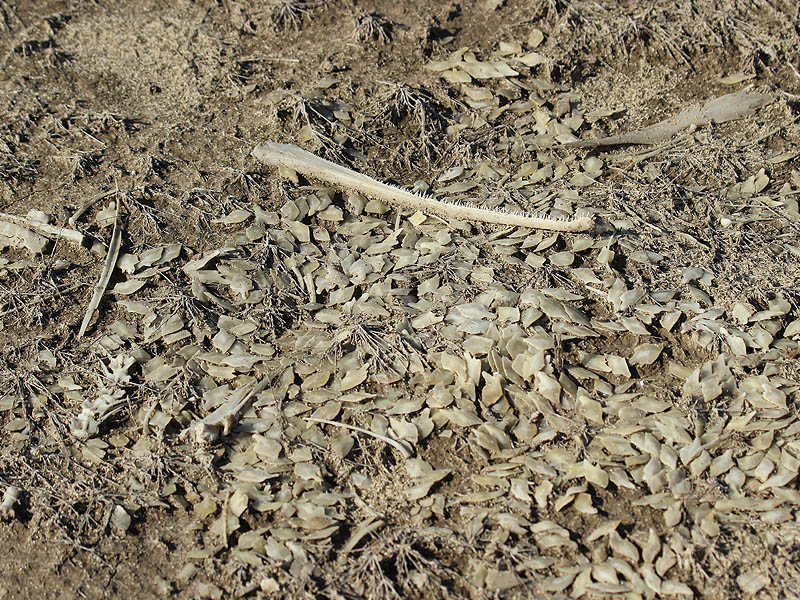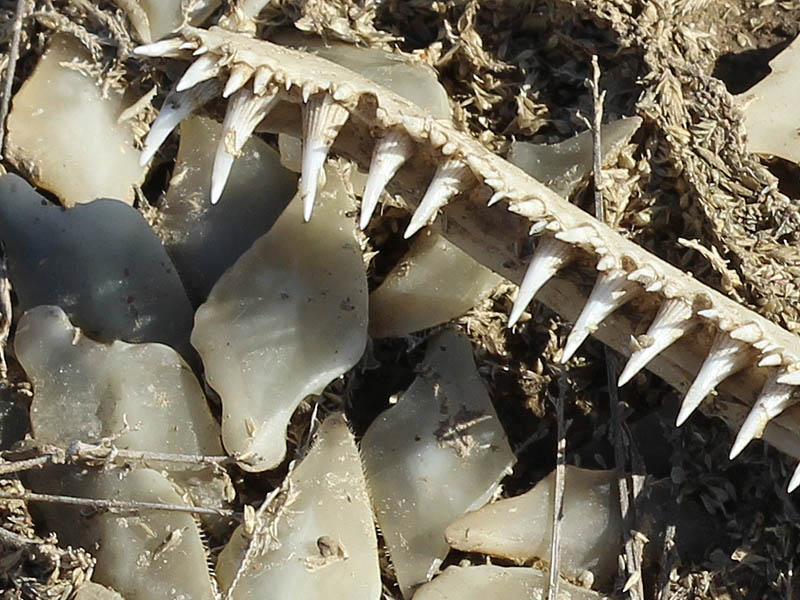These fish remains (likely a Longnose Gar) were found on the dried lake bed of far north Lewisville Lake. Scales and bones where in abundance. Most notable was a lower jawbone filled with needle-sharp teeth.




Documenting the Diversity of Dallas/Fort Worth Urban Wildlife Since 2005
These fish remains (likely a Longnose Gar) were found on the dried lake bed of far north Lewisville Lake. Scales and bones where in abundance. Most notable was a lower jawbone filled with needle-sharp teeth.




Given the dimensions of the jaw and rostrum shown, I would suggest that the pictured remains might be long-nose gar, rather than spotted. What characteristic suggested to you spotted gar?
Well, I was hoping that I would get a comment or email like this about this post. I have no idea what kind of gar these remains belong to. I researched it to the best of my ability, but could not reach a satisfactory id. I certainly see your point about the dimensions of the jaw… It seems long and thin, but without the other half attached I didn’t feel comfortable trying to make a judgement about how broad this fish’s snout would be. My list of questions goes on and on… maybe its possible to make judgements based on the size and layout of the teeth… It looks to me as if there is a double row of teeth… maybe you can make judgements based on the scale size and shape… I don’t know. I finally settled on Spotted Gar because I perceive them as being the most common gar (I may be wrong about that too), and also in hopes hope sparking a challenge like the one you posted. You should drop me an email using my contact form, and we can try to talk it out. I’d really like to get a positive id on this one!
The double row of teeth characteristic to differentiate between Alligator Gar (with double row) and other gars (with single row) is for the upper jaw only. So, the apparent double row shown in the lower jaw is not relevant to the distinction. And, despite the quite straightforward way this is stated in guidebooks, even ichthyologists can be confused in trying to ferret it out on specimens. I witnessed a professor and a teaching assistant in an ichthyology course get into a lengthy discussion about the matter while examining a specimen. But, an Alligator Gar would have a very broad and ducklike snout.
Unfortunately, most other characteristics used for differentiation require such things as counting numbers of scales in a scale row, obviously not possible with this specimen. But, Longnose Gar has the snout more than twice as long as the rest of the head with its length 12 to 20 times its width , while Shortnose Gar and the Spotted Gar have the snout length 5 to 7 times its width. The jaws in the photo appear to me to fit the former proportions much more closely than the latter. Measurements in the photo could probably be taken. My estimate from the screen comes out almost at 20 times, but the orientation makes it uncertain.
I am pretty confident of Longnose Gar, which btw in Texas reservoirs is much more common than Shortnose Gar and Spotted Gar, though the Spotted Gar is likely more common in rivers and streams.
I agree with David, given the photos and surrounding information, I would say this is much more likely to be a longnose gar than spotted gar mandible. Spotted gars would have broader bones in most cases (based on inspection of many spotted, longnose, and other gar skulls). Feel free to email me for further discussion. Great pics, thanks for posting!–
–solomon
EDITOR’S NOTE: Updated article on Mar 17, 2013 to show that specimen is likely a Longnose Gar rather than a Spotted Gar as first supposed.